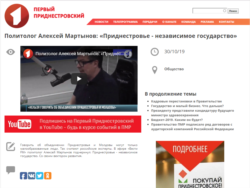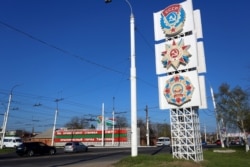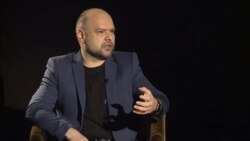On Oct. 30, First Transnistrian TV, which is owned by the authorities in the breakaway Moldovan region and broadcasts in Russian, aired a report headlined “Political Scientist Alexey Martynov: ‘Transnistria is an Independent State.’ ” The report was based on an interview of Martynov, director of the Moscow-based International Institute of the Newly Established States, first broadcast on Oct. 26 by Vesti FM, a Russian sate-owned radio station. Martynov discussed the fate of the unrecognized republic of Transnistria and recent Moldova elections, on a program called “Byvshiye” (“Former”).
Reporting on the Vesti FM interview, the First Transnistrian TV journalists drew on elements of the interview by Martynov and misrepresented them as a direct quote or restatement.
What did Martynov actually say?
In the radio interview, Martynov did not make the verbatim statement that “Transnistria is an independent state.” According to a recording of the program available on Vesti FM’s website, Martynov said: “So for over 25 years, more than quarter of century, the Moldovan Republic of Transnistria has been developing absolutely on its own, and on a separate vector. Transnistria has always demonstrated an independent vector of development oriented primarily towards Russia, a greater [Russia]. That is why they have considered and continue considering themselves as part of a greater Russia.”
Martynov also commented on the size of Transnistria’s population: “Some say frivolously, ‘Well, 500 thousand, so what?’ What do you mean, so what? Things like that could be said only by some anonymous Telegram users, not well educated, and not really burdened with elementary conscience and decency, etc.”
In the First Transnistrian TV report, phrasings in these separate comments by the Russian political scientist were then summarized this way: “Only uneducated people can talk about the unification of Transnistria with Moldova. That is the opinion of the Russian experts. In the Vesti FM broadcast, political analyst Alexey Martynov underlined: Transnistria is an independent state. With its own vector of development.”
How did Transnistria emerge?
Transnistria is a historically Moldovan territory consisting of eight cities and has a total population of 475,665. It emerged as a de facto “autonomous territory with a special legal status” after the collapse of the Soviet Union and the establishment of the independent Moldovan state.
Transnistria declared itself an independent sovereign state in August 1991. The Russian-speaking separatists fought a brief war with Moldovan security forces. That led to a Russian-mediated ceasefire and the establishment of a quasi-independent or de facto state in the Transnistrian region.
In 1991, Transnistria elected its first president. The active military phase of the conflict ended in 1992, with 286 killed on Moldovan side and 804 Transnistrian lives lost.
Today the Moldovan Republic of Transnistria operates as an unrecognized quasi-independent state with its own government, currency, passports and prison system.
The Russian military first entered Transnistria as a “peacekeeping force.” The UN General Assembly revoked that status in June 2018, demanding that Russian military leave. Moscow refused. A Russian army unit is based in Kolbasna, and the Russian defense ministry regularly posts updates about its unit in Transnistria, including reports on the unit’s frequent drills.
Experts draw parallels between Transnistria and the Georgian breakaway regions of Abkhazia and South Ossetia, and eastern Ukraine. Russia has played a role as mastermind and mediator in those conflicts.
Is Transnistria an independent state?
The First Transnistrian TV report promoted the idea that Transnistria is a sovereign state. There are several reasons why that is false, Andrey Andrievsky, a political analyst in the Moldovan capital of Chisinau, told Polygraph.info.
The main reason, he said, is that no UN member state or nation has recognized Transnistrian independence; Abkhazia and South Ossetia are the only two territories that have done so.
First Transnistrian TV attributed to Martynov the following words he in fact did not say: “To bear responsibility for the peoples living in the post-Soviet space, including for the people of Transnistria, is Moscow’s historic mission.”
This is what Martynov actually said: “It is difficult to call Moldova a sovereign state, it is very difficult to call even Ukraine a sovereign state today. Despite its size, a somewhat better or worse economy, but in any case, we bear responsibility – it is our space, and our responsibility.”
Martynov’s contention that Transnistria is oriented toward Russia appears partly rooted in a 2006 referendum that overwhelmingly supported unification with Russia.
Chisinau, however, said the referendum was illegitimate, as did the U.S. and the European Union.
According to Andrievsky, less than 8 percent of Transistria’s economy involves Russia.
“Most importantly, Russia, while declaring itself the main protector of Transnistria’s independence, never officially recognized it,” Andrievsky said. “Moreover, at every opportunity Moscow expresses its respect of Moldovan sovereignty and refers to Transnistria as a Moldovan territory.”
This article is written by a Moldovan journalist Elena DERJANSCHI who is on a fellowship at the Polygraph.info, Voice of America’s fact-checking unit.











